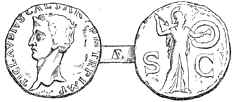|
remains, though somewhat of a negative character,
it is on the whole favourable in its results to the views
which have been advanced in the foregoing pages. No
Roman foundations have been discovered within the limits of the present town, though we have indeed one
instance, at the end which lies somewhat contiguous to
the spot assigned to the Roman station and " vicus," of
which mention will be made presently more particularly.
Indeed, it has almost passed into a matter of course to
consider that when deep sewers are dug in the streets,
or other excavations made, none will be met with. It
is probable then, as the whole tract was known to have
been comprised anciently within the limits of the Weald
of Kent, that in the time of the Romans much of the
actual site of the town was a deep and secluded part of
the forest, too densely covered with wood and thickets
to supply proper localities for Roman villas. The other
objects which are found are chiefly urns and coins. Very
many years ago some of the former were found in digging
the foundation of a warehouse in the angle between
Earl Street and Pudding Lane, north of the latter.
(See Newton's ' History of Maidstone,' p. 6.) A small
urn or two were likewise found about eight years since,
while excavating for a building in St. Faith's Street,
opposite to the top of what was the former Green.
Likewise, about twenty years before the said period, a
few small urns, like the former ones of a black colour,
and now deposited in the Charles Museum, were found
in digging foundations four or five houses higher up
the street on the same side. Of coins, a second brass of

A second brass of Claudius
|